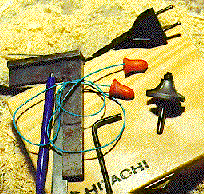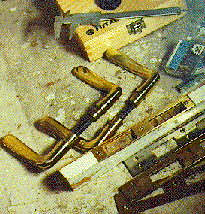|
|
||||
| INTRODUCTION | LESSON 1 | LESSON 2 | LESSON 3 | LESSON 4 |
All designs and the execution of the wood works presented here are the work of a member of the carpenters guild of Zürich. In Europe restoration work on protected buildings are indeed preferably given out to members of the still existing medieval associations of craftsmen. A main goal is to stick as much as practical to traditional handcraft methods, yet profit of modern tools which permit to greatly accelerate the single work steps. This approach permits to stick to the historic designs and construction methods and make the most of progress in tooling to keep down time costs to acceptable levels.
Reused, if possible antique raw materials are used as much as feasible. A large part of the effort is invested in old materials gathering. Destruction or renovation of buildings often permit to gather well preserved parts such as doors, windows, ramps, staircases, floors or paneling. At this place I like to thank to all of those who have given me important information as of the availability of such materials. A special thank to all the architects and construction supervisors who have greatly helped with the restoration of Epanvilliers by permitting me to collect old materials which were often going back to the beginning of the 19th century. Some doors could not be found and had to be bought from the antique market. As an excellent source I found Mr. Florian Langenbeck in Freiburg, Hochdorf "Historische Türen, Schlösser, Beschläge" (phone: 0761/135801)

Concerning door frames the traditional design is block construction (see for instance "Handbuch der Holz Konstruktion, Hans Böhm, Berlin 1911). Core parts of pine wood (pinus silvestris) is preferably used for window and door frames. Straight pieces (6 x 8 cm) which do not show any torsion (look straight down, then place the beam on the floor and wiggle it to check for torsion before buying it). All door openings have been measured paying attention to all relevant details and pictures have been taken of every opening.



Special attention has to be given to safety aspects at all times. Just about all modern power tools have a great potential for injury if not handled with care. Keep cleaning up your work space between every operation. Ready all necessary tools before starting an operation. Safety problems frequently arise when missing the right tool at the right time. Always keep your tools in excellent working conditions. Always wear goggles when entering your work area. Just about every power tool can project a splinter into your eye!
Keep the power plugs pulled at all times except when your doing the
cutting, drilling, planing operations. Pull the plug after every
cut! Always wear ear plugs when using a milling tool as the high
frequency noise generated, even by hobby machines, will rapidly kill your
hearing. Use only very sharp tools, preferably use the more expensive
metal cutting tools even when cutting wood. In the long run you save, as
they last far longer. Always move the wooden beam in the opposite
sense of the tool motion. Keep the bites small, particularly when
it is the initial bite which defines the cut. Use a setup on your
milling machine allowing pre-settable stops, thus allowing to proceed in
small repetitive steps (see lesson 1). Assemble all necessary components
before starting your work. This is particularly important when reusing
materials. I always try to get all of the removed parts, even the nuts
and bolts, when recuperating the material. This can save a lot of
time and bad and costly surprises. Standards always change with time
and are different between nations.